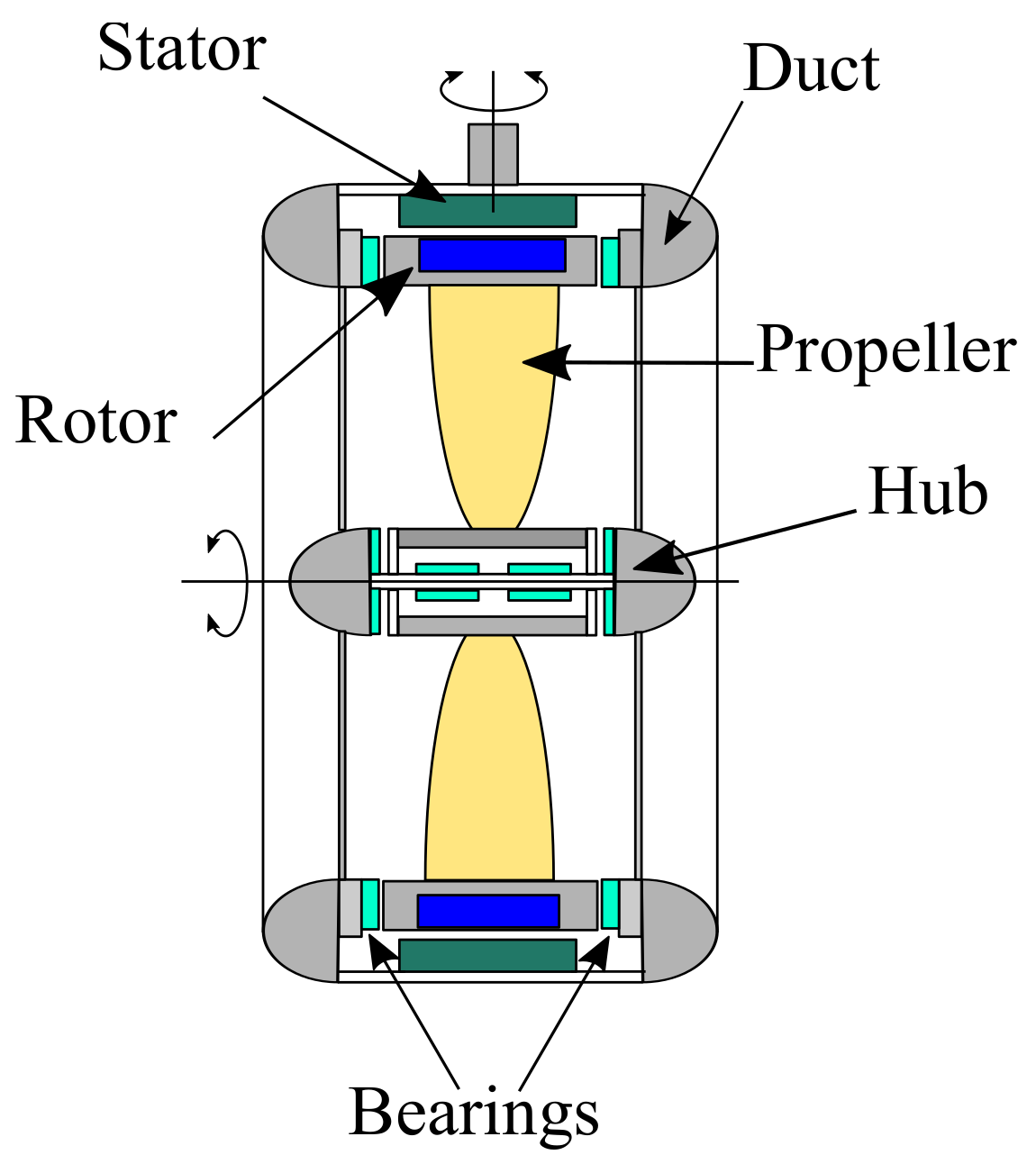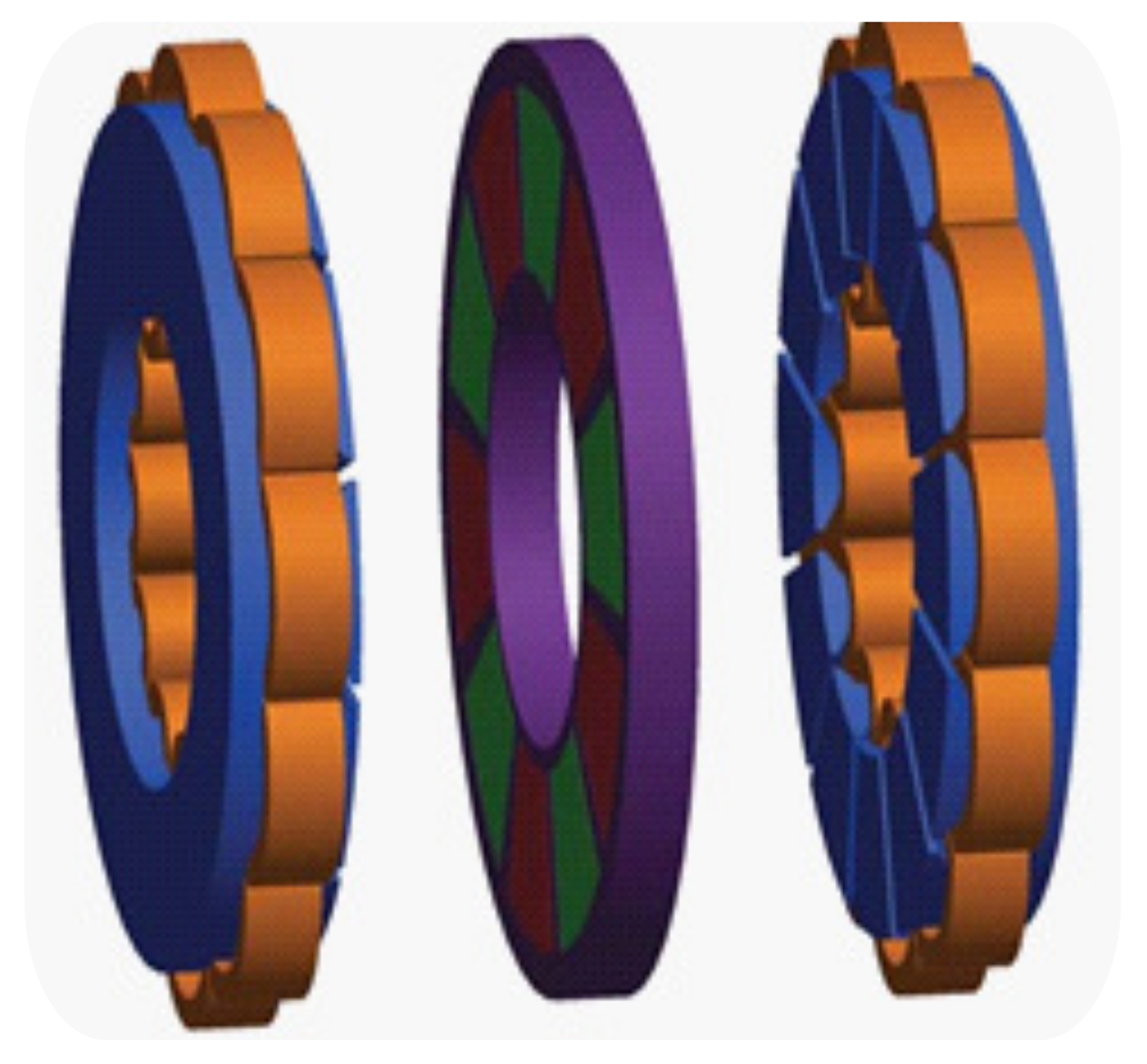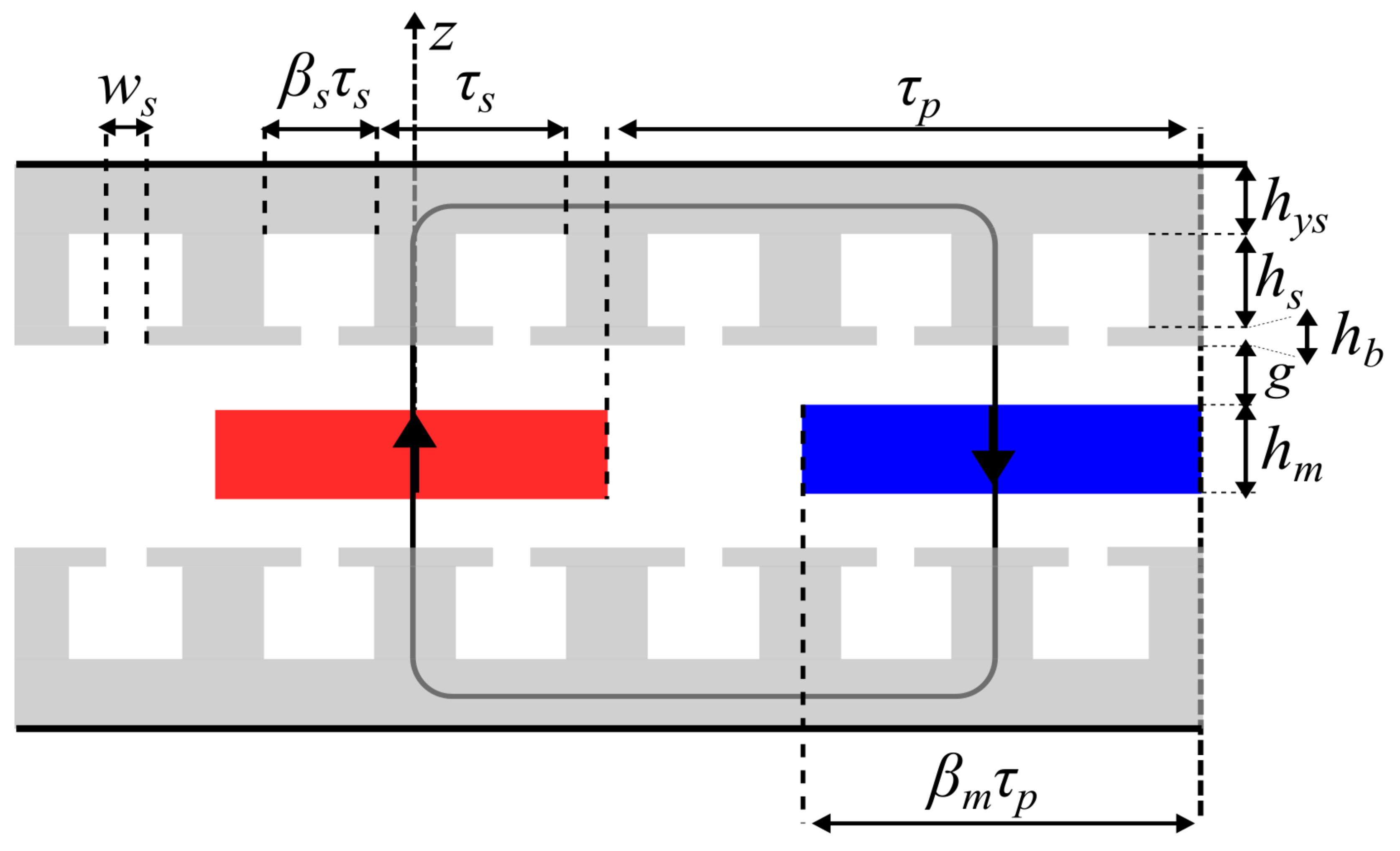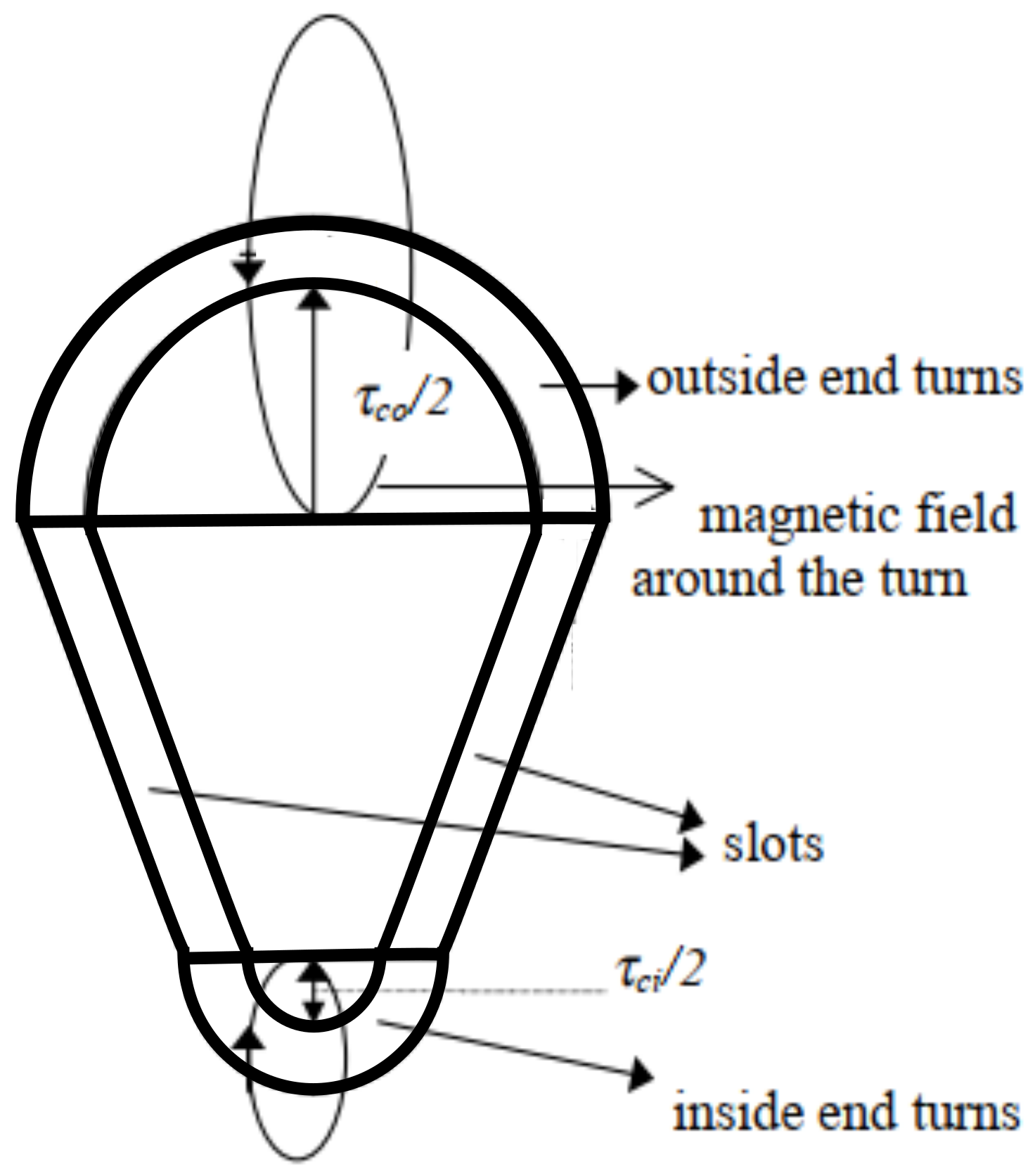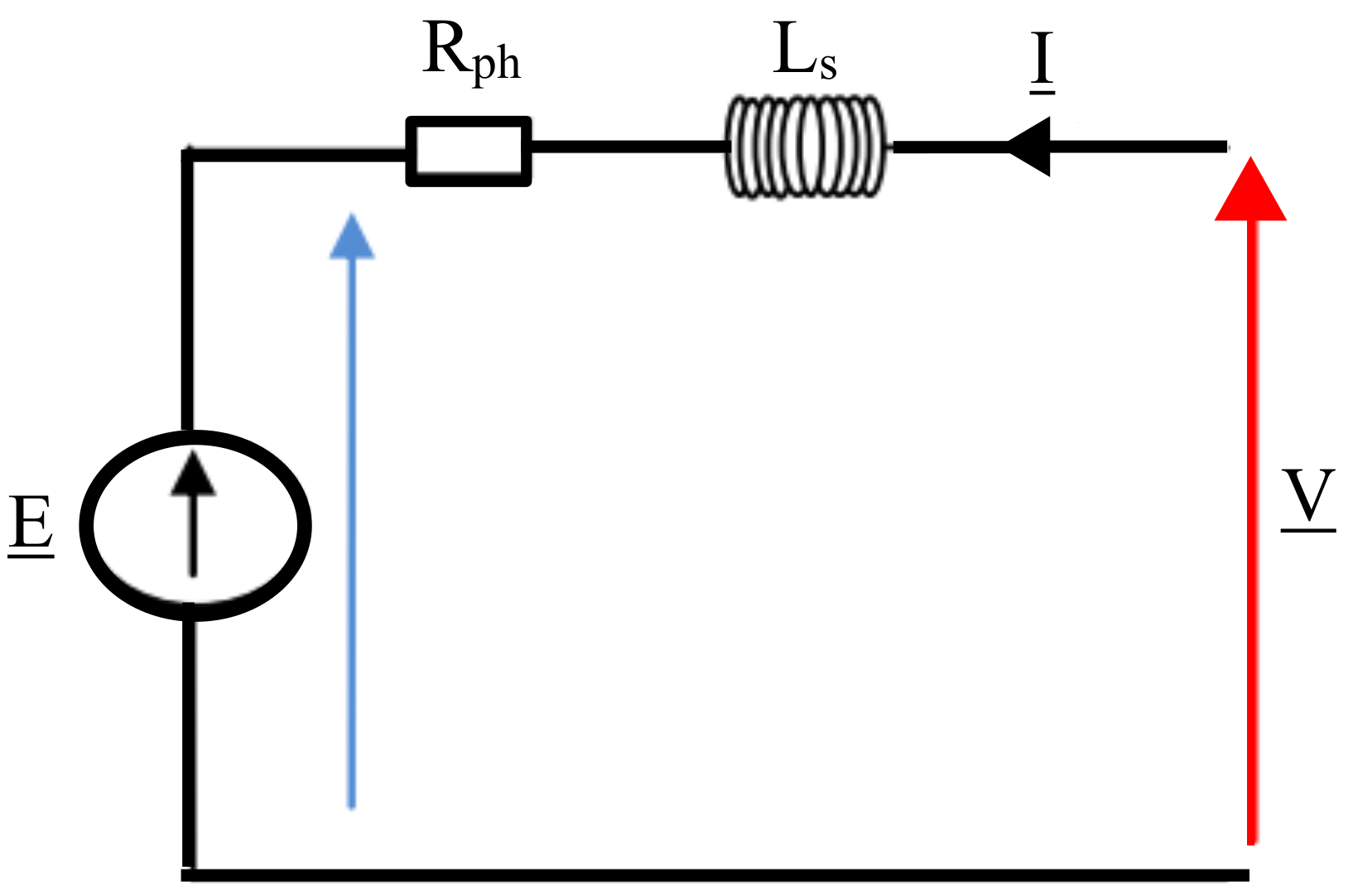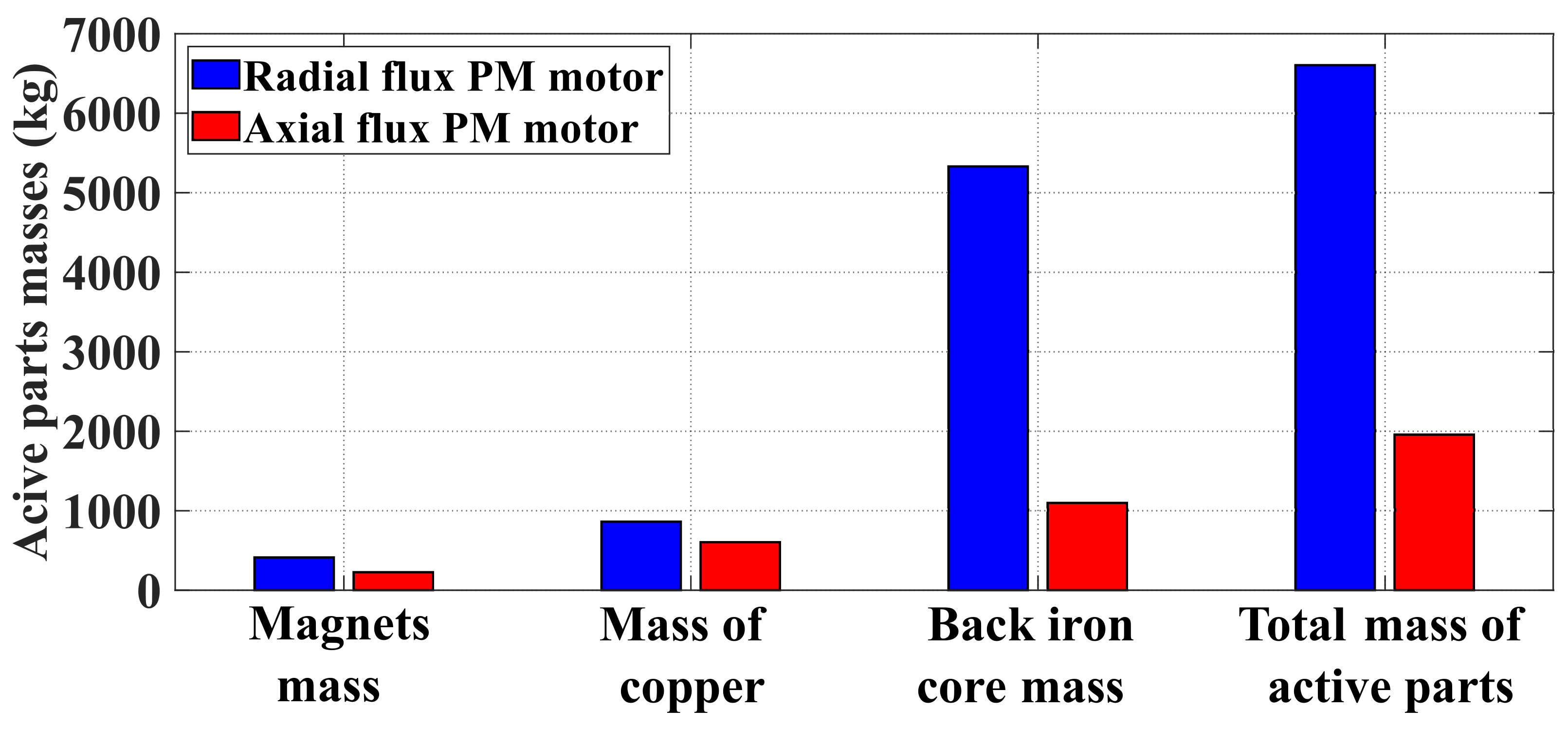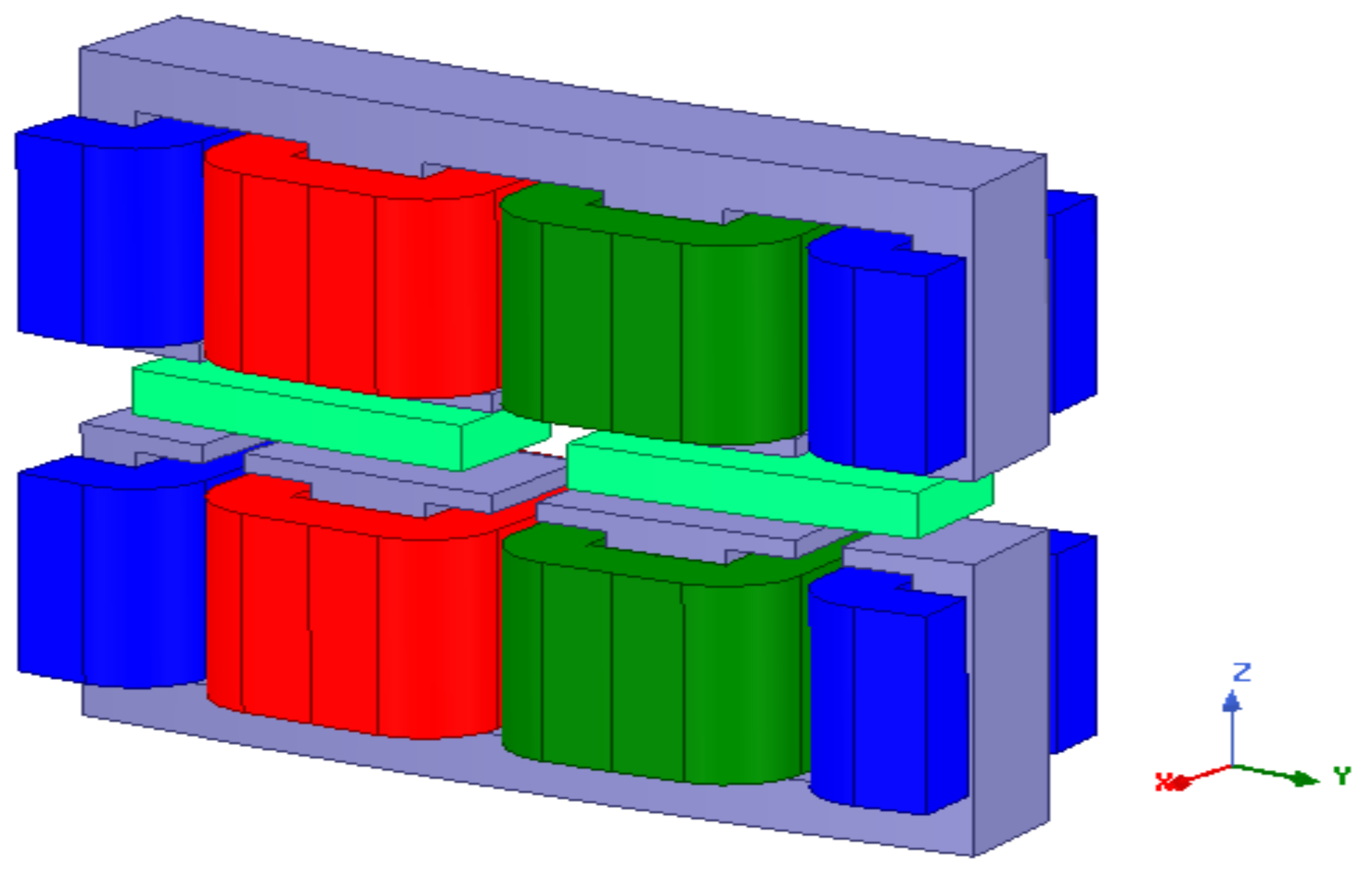1. Introduction
Naval electric propulsion has undergone considerable development in recent years and has taken on particular importance, leading to a large number of achievements [
1]. Electrical propulsion has many advantages in terms of ship maneuverability, maintenance, and acoustic noise [
2]. In addition, the military navy has shown interest in this technology as a means of propelling ships. The choice of the propulsion system for modern naval vessels depends on criteria such as changes in operational requirements, shock resistance, noise reduction, greater speed range, greater mission flexibility, longer periods away from base with reduced crews, and cleaner emissions [
3]. The electrical energy on this type of vessel is classically produced by thermal machines associated with alternators or by other power sources (fuel cells, energy storage systems) [
4] and is distributed on board by an AC or DC electrical network to the various systems on board and to the propulsion system [
5]. This type of architecture offers greater flexibility, efficiency, and fault tolerance than conventional mechanical propulsion architecture [
6]. The electrical propulsion chain includes a converter/motor system associated with propellers operating at variable speeds [
7].
Electrical propulsion allows using a podded propeller where the electrical motor is located in a nacelle outside the hull [
8]. Concerning the motor and propeller association, classically, the propulsor with outboard drive (POD) motor is located in a nacelle located behind the propeller blades. However, other emerging technologies have been studied in the last decades. This solution consists of rim-driven systems, where the propeller and propulsion motor are fully integrated [
9]. In addition, direct-drive permanent magnet motors appear to be the most promising solution that fulfills the requirements of the marine industry [
10], especially in terms of high efficiency and reliability [
11].
The electric rim-driven thruster is a ducted propeller that includes the electrical motor in the duct. The stator of the machine is integrated into the duct, and the rotor is built in a ring surrounding the propeller blades [
12]. As a result, the electrical motor air-gap can be filled with seawater. Therefore, the active parts (windings, magnets, magnetic cores) are sealed with specific materials to protect them from corrosion [
13]. However, seawater can contribute actively to the motor cooling, and the winding current density can be augmented easily [
14]. The permanent magnet machines are used in rim-driven propulsors, especially the axial flux permanent magnet machines, which are characterized by high 3D electromagnetic effects [
15,
16]. Furthermore, rim-driven machines usually have a large diameter. However, these machines generally have a short axial length. The large diameter requires that the back-core radial depth should be as small as possible to avoid becoming overweight. These machines usually have to be operated at slow speeds, which requires a high number of poles, thus reducing the radial core depth and minimizing the weight and size of the machine [
17].
Compared to the traditional electric podded propulsion system, the electric rim-driven propulsion system has certain advantages, such as better hydrodynamic efficiency, protection of the blades, and high power density [
18]. Indeed, it provides a high degree of integration, and the cabin collapses the complicated propulsion shaft system, additional components, propulsion motors, and other equipment into a compact and weight-saving structure [
19]. In addition, in rim-driven technology, a shaftless propeller can be used. This is a marine thruster that does not require a shaft or gearbox to transmit driving torque [
20].
Thus far, most published works regarding the modeling and design of AFPM machines for rim-driven applications used numerical simulations with 3D finite element analysis (3D-FEA) [
21,
22], which is very expensive and time-consuming, especially when the accuracy of results is required [
23]. To overcome this issue, some researchers have developed simple analytical models [
10]; the authors designed and analyzed the performance of axial flux permanent magnet generators for rim-driven marine turbines. A comparative study was then made with a radial flux generator which was optimally designed with similar models and specifications. Additionally, multi-physic models (hydrodynamics, electromagnetic, and thermal) were developed and a method to couple them for the design of an integrated rim-driven tidal turbine system was presented in [
13]. However, these two studies are based on analytical first-order electromagnetic models, which are not efficient for fully taking into account 3D effects. For validation purposes, the team of the French Naval Academy Research Institute in Brest, France, developed and tested a prototype of a rim-driven marine current turbine using a radial flux permanent magnet (RFPM) generator [
24]. In other works, a rim driven motor with a Halbach array with uneven segments was optimized to maximize the electromagnetic torque. Moreover, a new kind of segmented Halbach permanent magnet motor for integrated motors was designed and fabricated in [
25]. The motor has no bearings and employs a Halbach array in its rotor structure. Furthermore, the multicomponent fluid method is used to calculate the thermal and fluid field of the integrated motor propeller. In addition, the coreless, slotless, and slotted stators of an integrated motor were compared in [
14]. Furthermore, the calculation and analysis of frictional losses on the motor rotor in the flow field of the space between the stator and the rotor of the Rim-driven motor were studied. The development of an efficient propulsion system and the design of the hub-less, rim-driven propeller through multidisciplinary integration (hydrodynamics, propeller shaping, electromagnetic, and drive circuits) were presented in [
26]. The authors in [
27] discussed the performance of slotless axial flux permanent magnet (AFPM) machines used for marine propulsion. A new modular arrangement of the machine’s stator winding was proposed, and experimental results were presented. In [
28], the authors proposed a new electric motor topology, called ring winding AFPM, for the rim-driven thruster (RDT). They also presented a new method for determining the specifications of the electric motor, taking into account the propeller and the hull. The design methodology and constraints of the ring winding AFPM were also reported. A numerical simulation comparison of the hydrodynamic performance of a rim-driven propeller and a ducted propeller was performed in [
29], using the same flow configuration, on a Ka-47 propeller inside a 19A duct. In addition, a comparison of open-water performance between hub-bed and unhub-bed rim-driven thrusters was carried out in [
30] based on the computational fluid dynamics (CFD) method. The achieved results show that the hubless RDT has a higher efficiency than the hub-type RDT. The design and optimization of high-power-density PMSMs for podded propulsion systems were studied in [
31]. The ship’s propeller characteristics were determined by parametric analysis considering the ship’s thrust requirements. Its configuration was optimized to ensure its high efficiency and to estimate the nominal engine power and torque.
In this paper, an electric rim-driven propulsion system based on a double stator ironless rotor AFPM motor is optimally designed for practical naval specifications already used in a RFPM motor designed for a classical POD propeller. In a first step (described in
Section 2), the hydrodynamic performance of the ship’s propeller is identified using parametric analysis and considering the propeller’s thrust, shaft power, and velocity requirements imposed within the specifications. Next, the propeller geometry is optimized to ensure its high efficiency, and the external diameter of the motor is evaluated. The second part of the paper describes the double stator ironless rotor AFPM machine and its main design parameters. Models which are used for the AFPM motor design are presented. Especially, the flux density in the air-gap is calculated using a fast 3D modeling method to evaluate the magnetic field in AFPM machines using a combination of magnetic charges concept, image theory, and 2D relative permeance functions. A design procedure is proposed based on an optimization algorithm. The proposed objective function, relevant constraints, and constant quantities are described. Then, the adopted motor AFPM design optimization algorithm is presented. In the last part, the optimized AFPM machine is compared to the RFPM machine designed earlier.
The main contribution of this paper is to propose a specific design method for AFPM machines used in RD propellers. This method used a fast dedicated electromagnetic model in an optimization procedure of the electrical motor taking into account rim-driven specifications and propeller hydrodynamic behavior.
3. Propeller Design Methodology
Naval electric propulsion systems consist of three essential parts: the power electronics stage, electric motors and propellers [
7]. As the characteristics of the propeller associated with the PM motor studied in [
32] are not known, this section will focus on the determination of a propeller design corresponding to the reference motor operating point. This propeller corresponds to the specification of a trampling cargo. The design of this propeller will provide dimensional constraints for the RD motor. Then, the choice and modeling of the electric motor designed for this application will be discussed.
In rim-driven structures, the rotor of the electrical motor is integrated with the propeller. The principal of a rim-driven thruster (AFPM motor and propeller) is shown in
Figure 1.
At a given advance velocity , the propeller delivers the desired thrust T, and the motor will have to operate in a steady state to produce the input torque and the propeller speed . In addition, the internal diameter of the motor will be fixed to be the blade’s external diameter D.
To determine the hydrodynamic performance characteristics of propellers, a method usually employed in propeller design and analysis consists of using non-dimensional propeller coefficients, namely the coefficient of advance (
), the thrust coefficient (
), the torque coefficient (
), and the propeller efficiency (
). The performance of any designed or standard propeller can be easily obtained using these coefficients, which are expressed as follows [
33]:
where
is the fluid density in kg/m
.
The values of these coefficients are determined by a reduced scale model test in a hydrodynamic basin or CFD calculation. In this study, it was decided to use a 4-blade-type Wageningen Ka 4-70 series propeller.
The performance of these specific ducted propellers was characterized in the Netherlands ship modeling basin [
13].
Figure 2 shows the thrust coefficient and efficiency curves of the Ka N19A series propeller with an area ratio
, and different values of reduced pitch ratios
from
to
.
The experimental curves of
and
can be expressed quite accurately by polynomial functions in terms of the advance coefficient
and the pitch ratio
as follows:
where the coefficients
and
are constants presented in [
34].
Generally, when designing a propeller, one takes a ship’s operating point (T and ) and deduces the performance of the required propeller ( and ). However, in this study, the opposite path is followed; one takes a propeller operating point ( and ) and deduces the ship’s advance speed and the most appropriate propeller that could produce the thrust imposed by the ship. The obtained propeller can then be associated with the reference POD motor or with the proposed AFPM motor in an RD structure.
The main specifications of the propeller are shown in
Table 2. The requirements of the electric motor, such as output torque (
), inner diameter (
), and rotational speed (
n) are considered equal to the propeller torque (
), propeller diameter (
D), and propeller speed (
), respectively.
The parameters considered fixed are
,
and
T, whereas
,
, and
D have to be determined. Their realistic ranges of values are presented in
Table 3.
Knowing
,
,
T,
,
, and
D, it is then possible to calculate the torque coefficient
, the thrust coefficient
, the advance coefficient
, and the efficiency of the propeller
. From
Figure 2, it is clear that only one pitch ratio
is fitted to a realistic operating point (
) that satisfies Equations (
1)–(
3). Therefore, an iterative process can be used to find a relevant in terms of propeller efficiency. Once the right pitch ratio has been found, it is then possible to deduce the advance velocity
, the efficiency
, and the diameter of the propeller
D from the model. The propeller diameter value is the main common dimension between the propeller and RD motor.
The propeller design and optimization procedure, which is presented in
Figure 3, was followed to find the propeller operating point that satisfies the propeller specifications for which the hydrodynamic efficiency is maximum and to derive the propeller diameter value. The calculation method used a model of propeller that is well known in the field of propeller design. It is based on a set of typical ducted propeller data obtained from tests in ship model basins. The interest of this model is that it is of good accuracy as directly derived from tests. Furthermore, thanks to this non-dimensional approach, it is possible to deduce the performances of a propeller whatever its dimensions, which is particularly interesting in the case of a systematic design process.
The first step of the adopted methodology includes the introduction of the propeller specifications such as the thrust, torque, and rotational speed of the propeller, providing an estimation of the main variables of the propeller. In our case, these parameters are the advance velocity, the pitch ratio, and the diameter of the propeller; all of them have to be calculated by the applied iterative algorithm and then the search for the operating point. Finally, if the obtained point is an operating point, i.e., it satisfies Equations (
1)–(
3), its corresponding efficiency is calculated and compared with the efficiency obtained by a previous operating point, and the greatest of them is kept. The process is repeated until the maximum hydrodynamic efficiency is achieved.
The design and analysis of the propeller were completed. The hydrodynamic performances of the propeller corresponding to the optimal operating point are given in
Table 4.
The hydrodynamic curve of the optimized propeller is shown in
Figure 4. In this curve, the thrust coefficient (
), the torque coefficient (
), and the propeller efficiency (
) from Equations (
4)–(
6) are plotted as a function of the advance coefficient (
). At the optimum operating point (marked on the curve), the designed propeller has an efficiency of 68.91%, which is quite satisfactory for such an application.
6. Optimization Results and Discussion
The objective of this section is to investigate the performance of the optimal double stator AFPM motor and to compare it with the reference radial flux PM motor, taking into account the specifications listed in
Table 6 and the proposed models and methodology presented in
Section 4. An optimization process is performed using genetic algorithm. This optimization algorithm is known as the GA function in MATLAB. This algorithm has successfully converged into an optimal design that satisfies all the imposed constraints. The main dimensions and performance characteristics of the optimized double stator AFPM motor are summarized in
Table 7 and
Table 8, respectively.
According to
Figure 12, the estimated total cost of the active materials of the optimized double stator AFPM motor is equal to 35,323
$. This value is lower than that corresponding to the total active parts cost of the reference RFPM machine, which is 59,424
$. A reduction of about 40.55% has been achieved. This shows that the design and optimization procedure followed seems to have achieved its main objective, i.e., the reduction of the total active parts cost of the double stator AFMP machine. Regarding the mass comparison, the double stator AFPM motor presents a reduction in the active parts mass of about 70% compared to the total active parts mass of the RFPM machine as shown in
Figure 13. Regarding the electromechanical performance of the designed AFPM motor, a very satisfactory torque density of 97.6 Nm/kg has also been achieved. This value is higher than the torque density of the RFPM motor, which is equal to 28.9 Nm/kg. In addition, the better compactness of the double-stator machine is due to the presence of a double air-gap. The use of an ironless rotor also contributes to the reduction of the iron mass. It can also be seen that for the AFPM machine, the copper mass is reduced by about 30% compared to the RFPM machine. In the AFPM machine, 10% of copper is located in the coil ends. This can be explained by its very low active length and the use of a more appropriate winding such as fractional slots winding
, which has allowed a significant gain in the volume of copper in the endwindings and an improvement in terms of efficiency. However, in this study, the masses and costs of the inactive materials used to ensure the mechanical performance of these motors as well as the manufacturing and assembly costs are not taken into account. Generally, axial flux magnetic structures are mechanically more complex than radial flux machines. Their manufacture and assembly are therefore more delicate and require more structural materials. This leads to additional costs and masses, which have not been evaluated in this comparative study.
The optimized AFPM motor has an efficiency and power factor of 97.95% and 0.96, respectively. Furthermore, at nominal operation, the single-phase current absorbed by the motor is equal to 561 A, with a current density of 2.53 A/mm. This low value can be explained by the presence of two stators, which allows segmentation of the power between the stators. Therefore, if a fault occurs in one of the stator windings or stator cores, the machine can be operated at half power by disconnecting one of the stators.
To confirm the validity of the optimal rim-driven AFPM motor’s EM behavior, a 3D finite element analysis (3DFEA) is carried out using the commercial software ANSYS (
Figure 14 presents the 3D geometry of the motor).
Figure 15 shows the axial magnetic flux density distribution in the middle of the air gap at the mean radius, obtained from the model used for the design process and 3D-FEA at no-load conditions. The obtained results demonstrate good agreement beetwen numerical and analytical models.
The back-EMF variation as a function of rotor angle is shown in
Figure 16. The back EMF calculated with the model used for the design is in very good agreement with the 3D-FEM computation. Furthermore, both axial flux density and back EMF have a sinusoidal profile and a low level of harmonic content (THD = 3.1%) as shown in
Figure 17. This leads to a low motor torque ripple value, as illustrated in
Figure 18.
Figure 19 shows the profile of the cogging torque, which was evaluated by estimating the differential magnetic pressure, as a function of the mechanical position of the rotor [
38].
The calculated cogging torque is also in good agreement with the 3D-FEM simulation. It can be seen that the maximum amplitude of the cogging torque is equal to 0.89% of the rated torque, which can be regarded as a low quantity in comparison with the rated torque developed by the machine. Based on the previous factors, it seems that the optimized AFPM motor will have good behavior in terms of vibration and noise. Moreover, the mapping of the flux density distribution over the different parts of the optimized AFPM motor obtained by the 2D-FEA for different positions of the magnet center, as shown in
Figure 20, indicates that the rim-driven AFPM motor’s stators core are not saturated during their operation.
